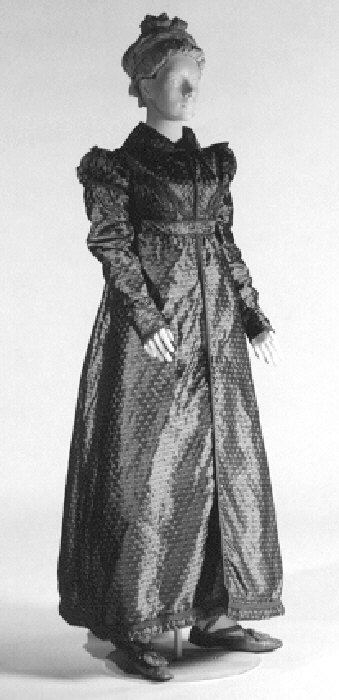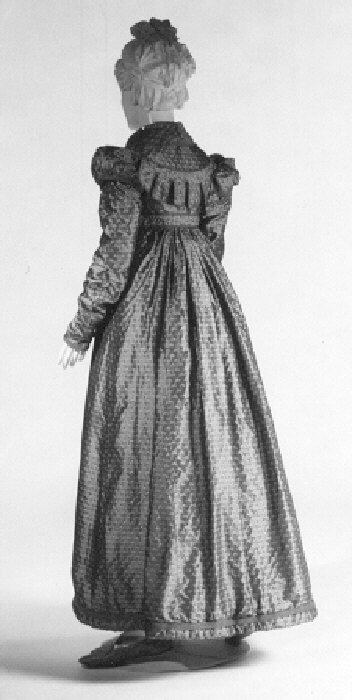Pelisse
Not on view
The fashionable female silhouette changed dramatically during the last quarter of the eighteenth century, when the prevailing influence was classical antiquity. Colored silks worn over panniers in the 1770s and "false rumps" in the 1780s gave way during the 1790s to sheer white cotton and linen worn over a simple chemise, or petticoat, clearly revealing the shape of the body. In addition, the low-cut neckline, high waistline, and short sleeves contributed to what was often referred to by social commentators as the "nude" look, which was criticized not only because of its perceived immodesty but for reasons of health as well. In fact, there was a variety of outerwear that protected against the cold, including woolen shawls, spencers (short jackets), and coatlike garments such as the pelisse.
The pelisse (called in France the redingote) underwent a transformation between 1775 and 1800. Previously a three-quarter length cloak with armholes and often a hood, of fabric or fur-lined or trimmed, the pelisse had evolved, by the turn of the century, into a long-sleeved, fitted coat, three-quarter to full length, which closely followed contemporary dress styles in shape and ornamentation. This later garment shows a wider range of fabrics and trimmings, often of contrasting colors. Depending on the season, the pelisse was made of cotton, silk, or wool and trimmed-usually on the collar, center front edges, cuffs, and hem-with fur, swansdown, lace, velvet, fringe, or silk plush.
This superb example is probably French and dates to about 1809. It is gray shot silk (with a different colored warp and weft) with an allover woven sprig pattern and trimmed with lead-gray silk-satin piping. It has a center front opening and a self-fabric belt with a concealed hook closure. The round collar, stiffened with an interlining, was often worn turned up; the bodice fronts are trimmed with diagonally applied bands of interlaced piping. The back bodice has the diamond-shaped seaming characteristic of the period. "Le style troubadour," an influence on women's dress since the late eighteenth century that drew on medieval and Renaissance costume, is evident in the short puffed oversleeve, the very long undersleeve covering the top of the hand, and the tabbed cape collar. At the wrist is an applied shaped cuff tacked onto the sleeve and secured under the arm with a hook and eye.
The skirt panels are gored to achieve a wider hem than had been fashionable at the turn of the century, a change that continued into the 1820s and beyond. At this date, however, the fullness is still concentrated at the center back, where the fabric is arranged in fine gathers, while at the sides and front it is stitched flat at the waist. Throughout this period, a small pad or roll was worn underneath to support the fullness.
Simultaneous with the widening of the hem was the shortening of the skirt. This pelisse is ankle length, several inches shorter than examples of the opening years of the nineteenth century, when the full-length pelisse hung to the top of the foot. The hem is padded, to hold it out in the new, wider line. The pelisse is lined in ivory silk and would have been worn over a cotton or other lightweight dress with a high, frilled, separate collar, again suggestive of an earlier period. Gloves and shoes may have been in a matching or contrasting color, and a hat would have completed the ensemble.
Due to rights restrictions, this image cannot be enlarged, viewed at full screen, or downloaded.
This artwork is meant to be viewed from right to left. Scroll left to view more.





